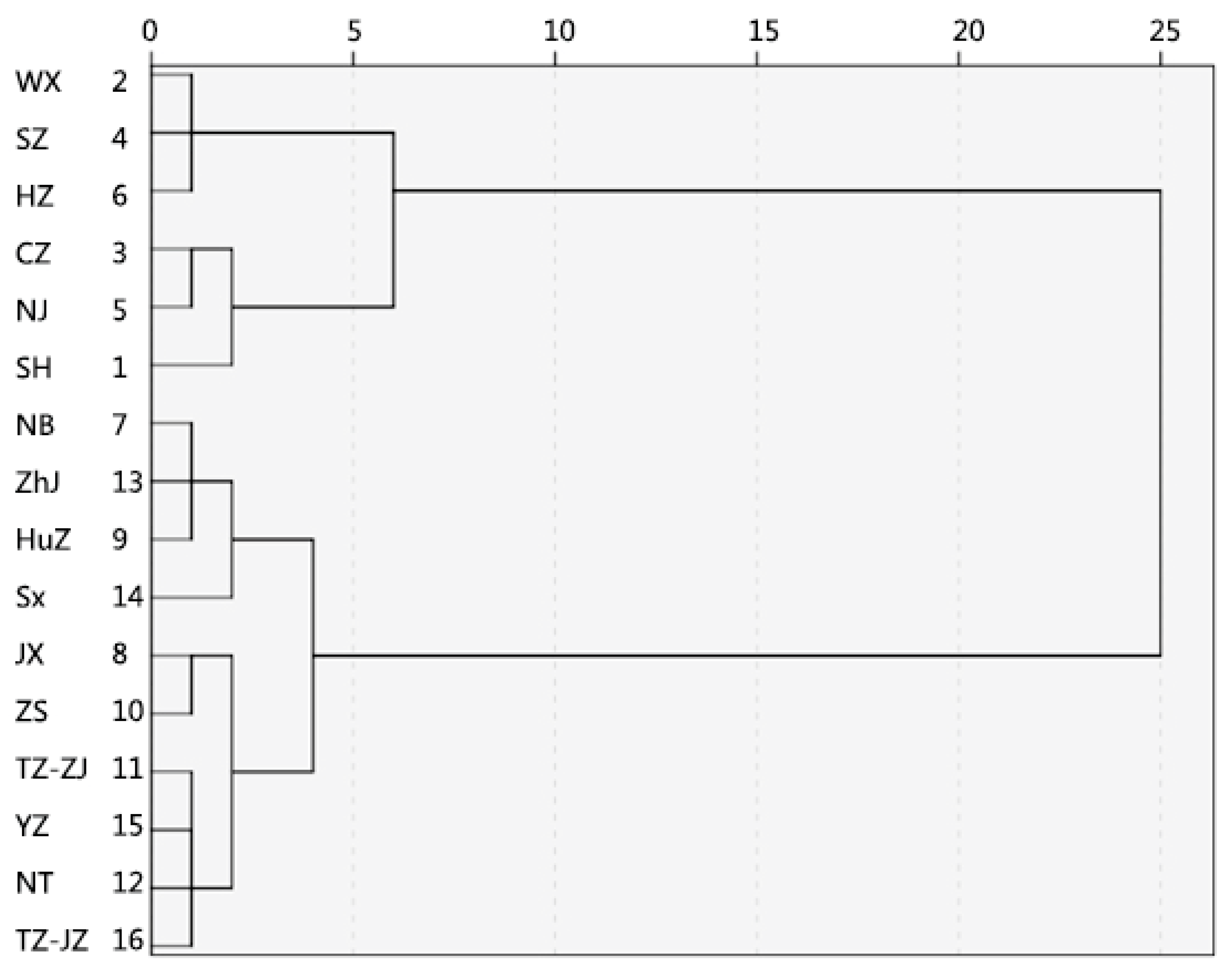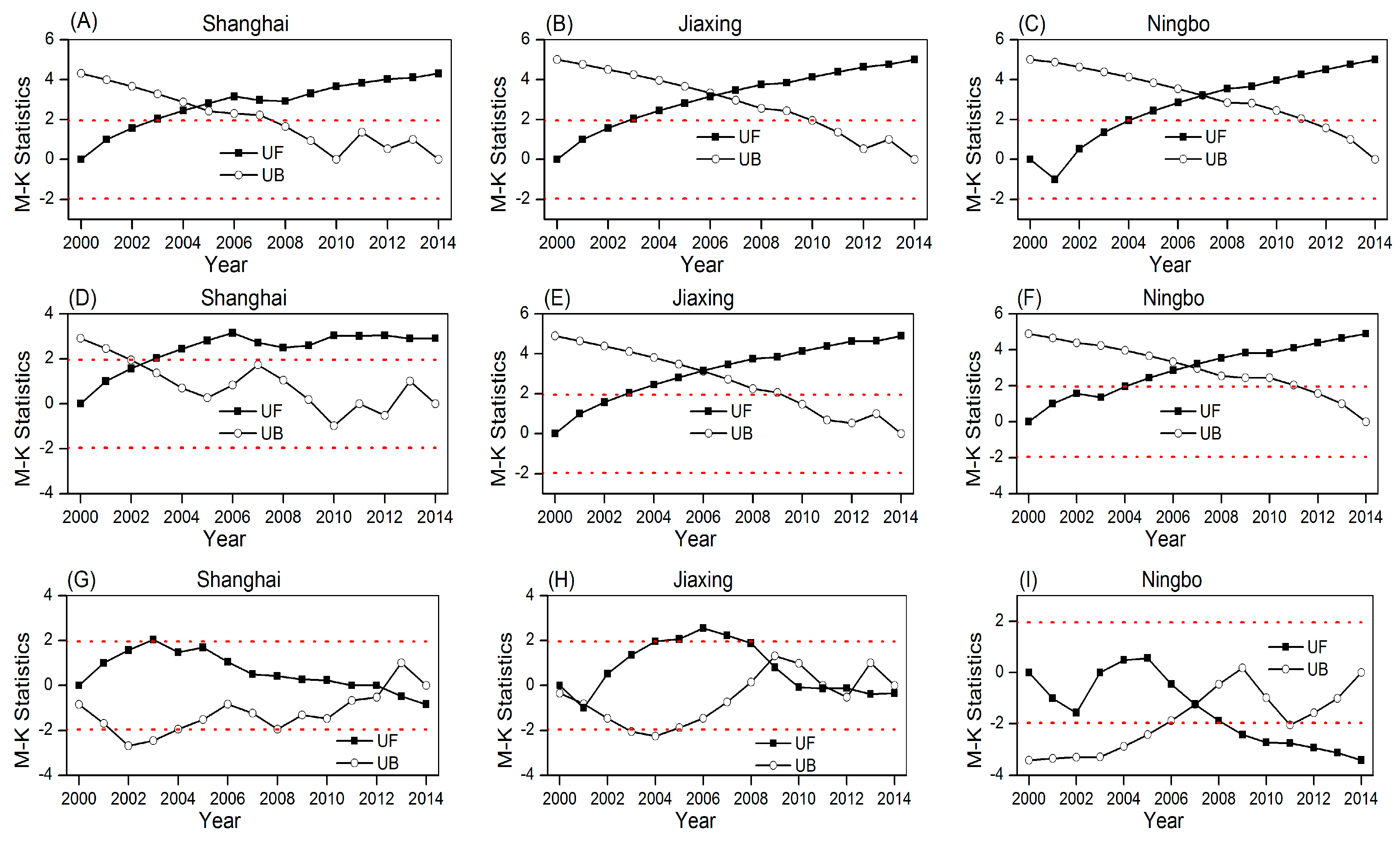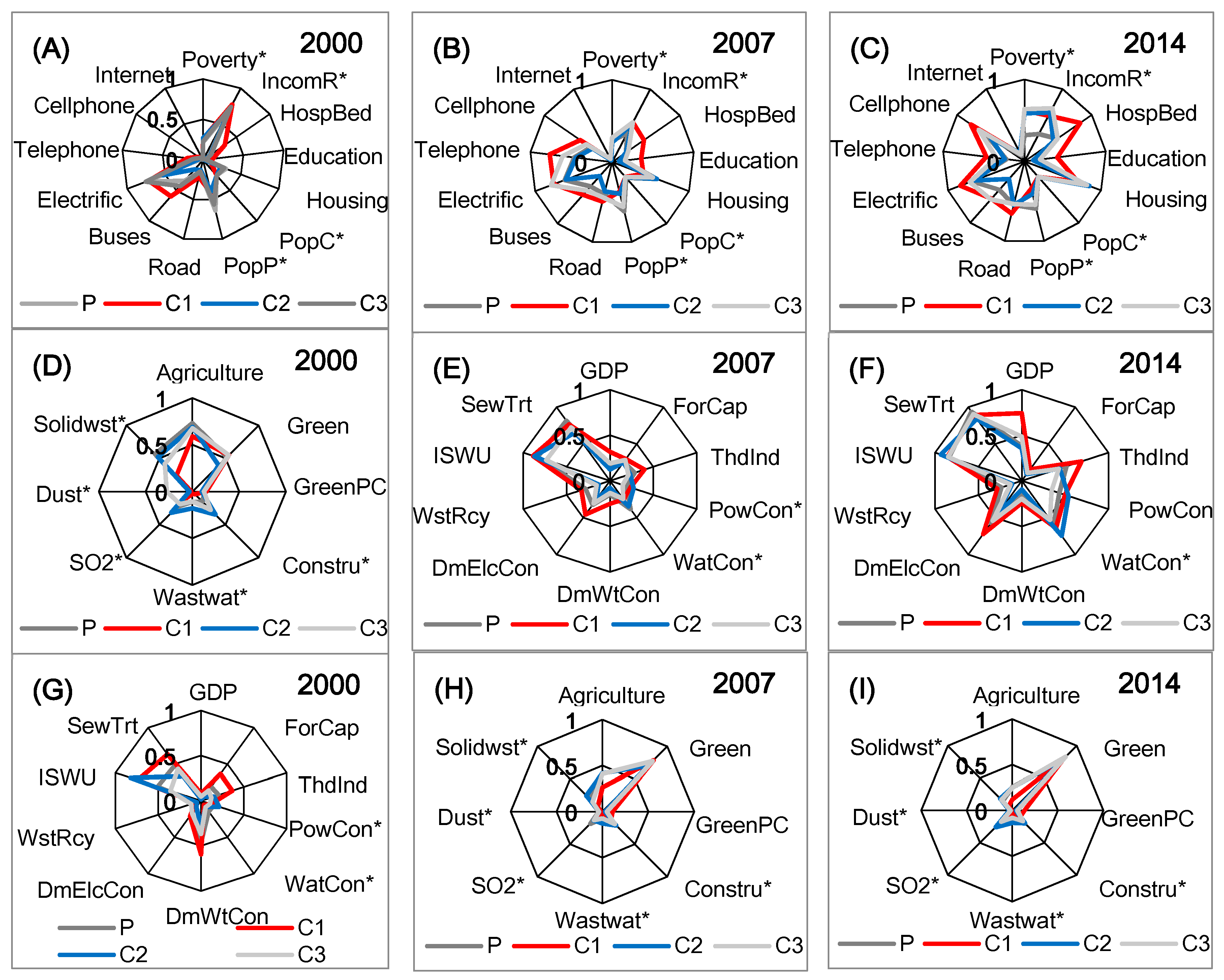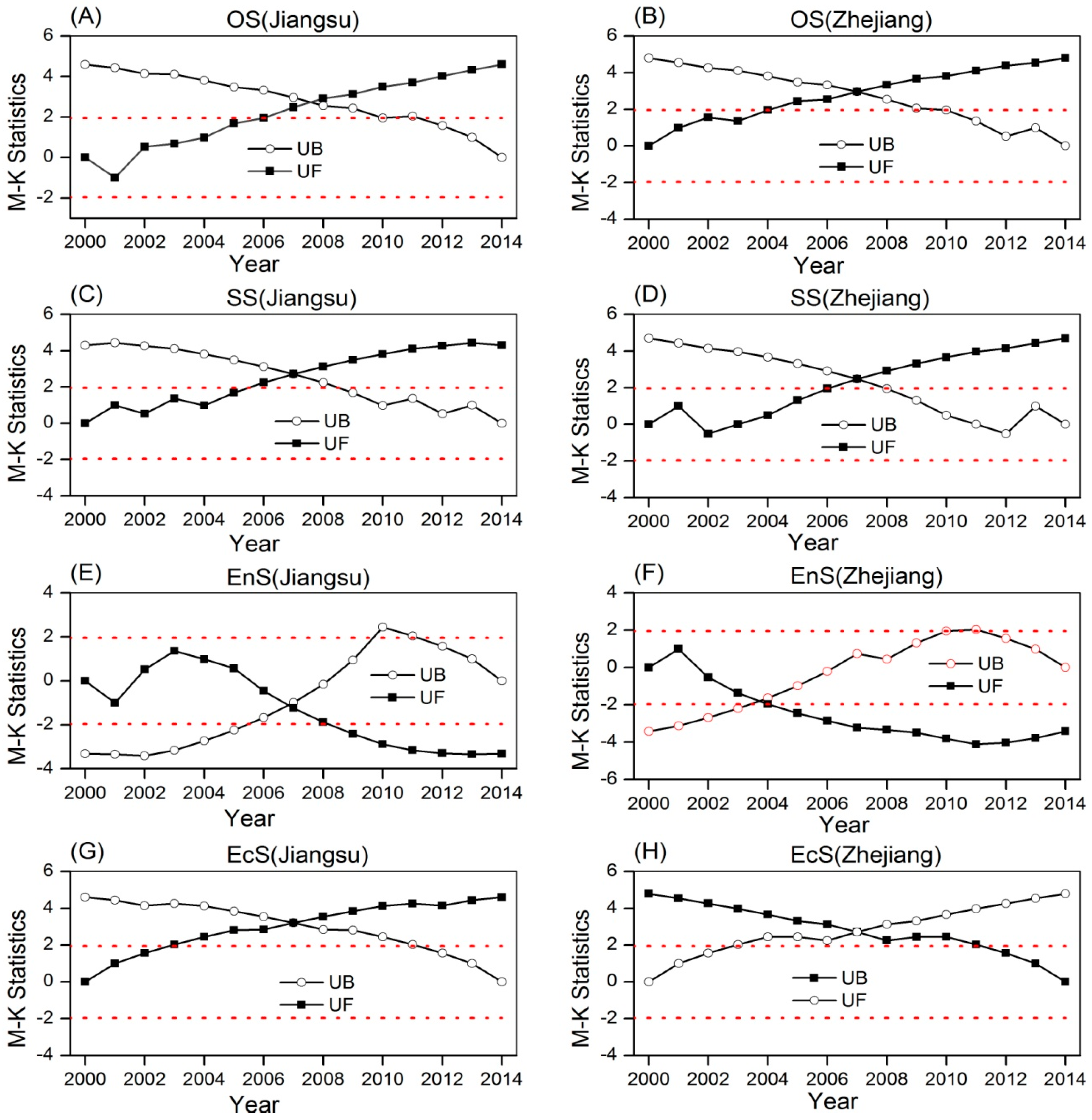Assessing Urban Sustainability Using a Multi-Scale, Theme-Based Indicator Framework: A Case Study of the Yangtze River Delta Region, China
Abstract
:1. Introduction
“Urban sustainability may refer to a set of dynamic conditions that satisfy the needs of current and future generations in an urban area, but it is more fundamentally an ongoing adaptive process of achieving and maintaining those conditions. Urban sustainability is defined as an adaptive process of facilitating and maintaining a virtuous cycle between ecosystem services and human well-being through concerted ecological, economic, and social actions in response to changes within and beyond the urban landscape”.(pp. 212–213)
2. Materials and Methods
2.1. Study Area
2.2. Data and Methods
2.2.1. Data Collection and Urban Sustainability Indicators
2.2.2. Data Gaps and Reliability
2.2.3. Mann-Kendall (M-K) Statistical Analysis
3. Results
3.1. Urban Sustainability of Cities at the Prefectural Level
3.2. Urban Sustainability of Cities at the Provincial Scale
4. Discussion
4.1. How Did Different Sustainability Dimensions Change over Time?
4.2. How Did Different Sustainability Dimensions Differ with Spatial Scales?
4.3. Implications for Sustainable Development in the YRD Region
- Firstly, the government should set short-term and long-term goals of sustainable development for cities. From strong sustainability perspective, the environmental development should be put in the first place in the long run, as a city cannot make genuine development without a healthy environment [8]. Meanwhile, realistic goals in the short run are also needed, based on the failures of sustainable development of YRD indicated by our study.
- Secondly, the government should combine development of cities at multiple scales to obtain sustainable development of YRD. As Bell and Morse [25] pointed out, “…the spatial scale is clearly very important when one attempts to put sustainability into practice or when one judges the level of sustainability of an existing system”.
- Thirdly, the GDP-based political performance of local government should be replaced. During the past decades, the blind pursuit of GDP caused excessive urban expansion in China [54] and, subsequently, many environmental problems. A new index, for example, natural resource consumption per GDP should be considered in the future.
5. Conclusions
Acknowledgments
Author Contributions
Conflicts of Interest
References
- Ding, X.H.; Zhong, W.Z.; Shearmur, R.G.; Zhang, X.L.; Huisingh, D. An inclusive model for assessing the sustainability of cities in developing countries—Trinity of Cities’ Sustainability from Spatial, Logical and Time Dimensions (TCS-SLTD). J. Clean. Prod. 2015, 109, 62–75. [Google Scholar] [CrossRef]
- United Nation. World Urbanization Prospects: The 2011 Revision. Available online: http://www.un.org/en/development/desa/publications/world-urbanization-prospects-the-2011-revision.html (accessed on 20 March 2016).
- Wu, J.G. Urban ecology and sustainability: The state-of-the-science and future directions. Landsc. Urban Plan. 2014, 125, 209–221. [Google Scholar] [CrossRef]
- Wu, J.G.; Xiang, W.N.; Zhao, J.Z. Urban ecology in China: Historical developments and future directions. Landsc. Urban Plan. 2014, 125, 222–233. [Google Scholar] [CrossRef]
- Cakir, G.; Un, C.; Baskent, E.Z.; Kose, S.; Sivrikaya, F.; Keles, S. Evaluating Urbanization, Fragmentation and Land Use/Land Cover Change Pattern in Istanbul City, Turkey from 1971 to 2002. Land Degrad. Dev. 2008, 19, 663–675. [Google Scholar] [CrossRef]
- Grimm, N.B.; Faeth, S.H.; Golubiewski, N.E.; Redman, C.L.; Wu, J.; Bai, X.; Briggs, J.M. Global Change and the Ecology of Cities. Science 2008, 319, 756–760. [Google Scholar] [CrossRef] [PubMed]
- Bugliarello, G. The future of urban sustainability. Sustainability 2010, 3, 351–359. [Google Scholar] [CrossRef]
- Huang, L.; Wu, J.G.; Yan, L.J. Defining and measuring urban sustainability: A review of indicators. Landsc. Ecol. 2015, 30, 1175–1193. [Google Scholar] [CrossRef]
- Wu, J.G. Landscape sustainability science: Ecosystem services and human well-being in changing landscapes. Landsc. Ecol. 2013, 28, 999–1023. [Google Scholar] [CrossRef]
- Alberti, M. Measuring urban sustainable. Environ. Impact. Assess. Rev. 1996, 16, 381–424. [Google Scholar] [CrossRef]
- World Commission on Environment and Development (WCED). Our Common Future; Oxford University Press: Oxford, UK, 1987. [Google Scholar]
- Dizdaroglu, D. Developing micro-level urban ecosystem indicators for sustainability assessment. Environ. Impact Assess. Rev. 2015, 54, 119–124. [Google Scholar] [CrossRef]
- Kates, R.W.; Clark, W.C.; Corell, R.; Hall, J.M.; Jaeger, C.C.; Lowe, I.; McCarthy, J.J.; Schellnhuber, H.J.; Bolin, B.; Dickson, N.M.; et al. Environment and development: Sustainability science. Science 2001, 292, 641–642. [Google Scholar] [CrossRef] [PubMed]
- Kates, R.W.; Parris, T.M. Long-term trends and a sustainability transition. Proc. Natl. Acad. Sci. USA 2003, 100, 8062–8067. [Google Scholar] [CrossRef] [PubMed]
- Wu, J.G. Landscape ecology, cross-disciplinarity, and sustainability science. Landsc. Ecol. 2006, 21, 1–4. [Google Scholar] [CrossRef]
- Huang, L.; Yan, L.J.; Wu, J.G. Assessing urban sustainability of Chinese megacities: 35 years after the economic reform and open-door policy. Landsc. Urban Plan. 2016, 145, 57–70. [Google Scholar] [CrossRef]
- Ness, B. Managing urban futures: Sustainability and urban growth in developing countries. Eur. Plan. Stud. 2007, 15, 167–168. [Google Scholar] [CrossRef]
- Wu, J.; Wu, T. Sustainability indicators and indices. In Handbook of Sustainable Management; Christian, N.M., Kuei, C., Eds.; Imperial College Press: London, UK, 2012; pp. 65–86. [Google Scholar]
- Parris, T.M.; Kates, R.W. Characterizing a sustainability transition: Goals, targets, trends, and driving forces. Proc. Natl. Acad. Sci. USA 2003, 100, 8068–8073. [Google Scholar] [CrossRef] [PubMed]
- Singh, R.K.; Murty, H.R.; Gupta, S.K.; Dikshit, A.K. An overview of sustainability assessment methodologies. Ecol. Indic. 2009, 9, 189–212. [Google Scholar] [CrossRef]
- UNCSD (The United Nations Commission on Sustainable Development). Indicators of Sustainable Development: Guidelines and Methodologies; United Nations: New York, NY, USA, 2001. [Google Scholar]
- Li, J.; Pu, L.; Zhu, M.; Liao, Q.; Wang, H.; Cai, F. Spatial pattern of heavy metal concentration in the soil of rapid urbanization area: A case of Ehu Town, Wuxi City, Eastern China. Environ. Earth Sci. 2014, 71, 3355–3362. [Google Scholar] [CrossRef]
- Morris, K.I.; Chan, A.; Morris, K.J.K.; Ooi, M.C.G.; Oozeer, M.Y.; Abakr, Y.A.; Nadzir, M.S.M.; Mohammed, I.Y.; Al-Qrimli, H.F. Impact of urbanization level on the interactions of urban area, the urban climate, and human thermal comfort. Appl. Geogr. 2017, 79, 50–72. [Google Scholar] [CrossRef]
- Zhao, Y.; Wang, S.; Zhou, C. Understanding the relation between urbanization and the eco-environment in China’s Yangtze River Delta using an improved EKC model and coupling analysis. Sci. Total Environ. 2016, 571, 862–875. [Google Scholar] [CrossRef] [PubMed]
- Bell, S.; Morse, S. Sustainability Indicators: Measuring the Immeasurable, 2nd ed.; Earthsan: London, UK, 2008. [Google Scholar]
- Jiangsu Statistical Bureau. Jiangsu Statistical Yearbook; China Statistics Press: Beijing, China, 2015; ISBN 978-7-5037-7507-9. (In Chinese)
- Shanghai Statistical Bureau. Jiangsu Statistical Yearbook; China Statistics Press: Beijing, China, 2015; ISBN 978-7-5037-7518-5. (In Chinese)
- Zhejiang Statistical Bureau. Zhejiang Statistical Yearbook; China Statistics Press: Beijing, China, 2015; ISBN 978-7-5037-7510-9. (In Chinese)
- National Bureau of Statistics. China City Statistical Yearbook; China Statistics Press: Beijing, China, 2001–2015; ISBN 978-7-5037-7706-6. (In Chinese)
- Li, L.; Wu, J.; Yue, C.Y. Studies on the Index System and Comprehensive Evaluation of Urban Sustainable Development (I). J. Wuhan Urban Constr. Inst. 2000, 17, 30–35. [Google Scholar]
- Li, L.; Wu, J.; Yue, C.Y. Studies on the Index System and Comprehensive Evaluation of Urban Sustainable Development (II). J. Wuhan Urban Constr. Inst. 2000, 17, 1–6. [Google Scholar]
- Song, F.H. A study of the comprehensive evaluation index system of urban sustainable development. J. Xinjiang Univ. (Philos. Humanit. Soc. Sci.) 2008, 36, 15–18. (In Chinese) [Google Scholar]
- State Environmental Protection Agency. Indicators for Eco-County, Eco-City and Eco-Province Construction (Revised Draft). Available online: http://www.gdep.gov.cn/zcfg/bmguizhang/201309/t20130903_154923.html (accessed on 19 June 2010). (In Chinese)
- Xu, X.Q.; Zhang, J.J. Comprehensive evaluation of Guangzhou urban sustainable development. Acta Geogr. Sin. 2001, 56, 54–63. [Google Scholar]
- Zhang, F.; Wang, Y.J.; Fang, C.L.; Jian, D.H. Urban sustainable development evaluation indices and basic models for cities in Jiangsu. J. Realism 2005, 7, 4–7. [Google Scholar]
- Alpopi, C.; Manole, C.; Colesca, S.E. Assessment of the sustainable urban development level through the use of indicators of sustainability. Theor. Empir. Res. 2011, 6, 78–87. [Google Scholar]
- Wilson, M.C.; Wu, J.G. The problems of weak sustainability and associated indicators. Int. J. Sustain. Dev. World Ecol. 2016. Available online: http://dx.doi.org/10.1080/13504509.2015.1136360 (accessed on 20 June 2017). [CrossRef]
- Song, Y.C.; Qi, R.H.; You, W.H.; Wang, X.R.; Zhu, L.B. A study on indices system and assessment criterion of Eco-city. Urban. Environ. Urban Ecol. 1999, 12, 16–19. (In Chinese) [Google Scholar]
- Gilbert, R.O. Statistical Methods for Environmental Pollution Monitoring; Wiley: Hoboken, NJ, USA, 1987; ISBN 978-0471288787. [Google Scholar]
- Kendall, M.G. Rank Correlation Methods, 4th ed.; Charles Griffin: London, UK, 1975. [Google Scholar]
- Mann, H.B. Non-parametric tests against trend. Econometrica 1945, 13, 163–171. [Google Scholar] [CrossRef]
- Liu, S.M.; Wang, H.; Yan, D.H.; Ren, Q.F.; Wang, D.; Gong, B.Y. Analysis of spatiotemporal evolution of isolated rainstorm events in Huai River Basin, China. Adv. Meterol. 2017, 2017, 3010295. [Google Scholar] [CrossRef]
- Hamed, K.H. Trend detection in hydrologic data: The Mann-Kendall trend test under the scaling hypothesis. J. Hydrol. 2008, 349, 350–363. [Google Scholar] [CrossRef]
- Bari, S.H.; Rahman, M.T.U.; Hoque, M.A.; Hussain, M.M. Analysis of seasonal and annual rainfall trends in the northern region of Bangladesh. Atmos. Res. 2016, 176–177, 148–158. [Google Scholar] [CrossRef]
- Gu, Z.J.; Duan, X.W.; Liu, B.; Hu, J.M.; He, J.N. The spatial distribution and temporal variation of rainfall erosivity in the Yunnan Plateau, Southwest China: 1960–2012. Catena 2016, 145, 291–300. [Google Scholar]
- Lutz, S.R.; Mallucci, S.; Diamantini, E.; Majone, B.; Bellin, A.; Merz, R. Hydroclimatic and water quality trends across three Mediterranean river basins. Sci. Total Environ. 2016, 571, 1392–1406. [Google Scholar] [CrossRef] [PubMed]
- Xiao, G.; Xue, L.; Woetzel, J. The Urban Sustainability Index: A New Tool for Measuring China’s Cities. Available online: http://www.urbanchinainitiative.org/en/resources/report_2.html (accessed on 20 March 2016).
- Blue book of Yangtze River Delta. The First Transition in the Yangtze River Delta; Social Sciences Academic Press: Beijing, China, 2010; ISBN 978-7-5097-1489-8. [Google Scholar]
- Liu, S.L.; Liu, X.J. Blue Book of Mega-City Regions: Report on China Mega-City Regions Development Index in 2013; Social Sciences Academic Press: Beijing, China, 2013; ISBN 978-7-5097-5094-0. [Google Scholar]
- Cai, C.M.; Shang, J.C. Comprehensive evaluation on urban sustainable development of Harbin city in Northeast China. J. Geogr. Sci. 2009, 19, 144–150. [Google Scholar] [CrossRef]
- UNDP (United Nations Development Programme). China Sustainable Cities Report: Measuring Ecological and Human Development; UNDP: Beijing, China, 2016. [Google Scholar]
- Zhang, H.Y.; Michinori, U.; Keishiro, H.; Helmut, Y. Land use change patterns and sustainable urban development in China. J. Asian Architect. Build. Eng. 2010, 138, 131–138. [Google Scholar] [CrossRef]
- Michael, F.L.; Noor, Z.Z.; Figueroa, M.J. Review of urban sustainability indicators assessment—Case study between Asian countries. Habitat. Int. 2014, 44, 491–500. [Google Scholar] [CrossRef]
- Ma, Q.; He, C.Y.; Wu, J.G. Behind the rapid expansion of urban impervious surfaces in China: Major influencing factors revealed by a hierarchical multiscale analysis. Land Use Policy 2016, 59, 434–445. [Google Scholar] [CrossRef]








| Theme | Sub-Theme | Indicators | Unit | References or Data Source | |
|---|---|---|---|---|---|
| Society | Equity | Poverty | Unemployment rate(the registered urban unemployment rate) (Poverty *) | % | [21,29] |
| Social equity | Ratio of urban residents’ income to rural residents’ income (IncomR *) | % | [38] | ||
| Health | Healthcare | Number of hospital beds per 10,000 inhabitants (HospBed) | / | [38] | |
| Education | Higher education achievement level | Number of higher education enrolled students per 10,000 inhabitants (Education) | / | [33] | |
| Housing | Living conditions | The housing construction area per capita in urban proper (Housing) | m2 | [21] | |
| Population | Population change | Natural population growth rate (PopC *) | ‰ | [21] | |
| Population pressure | Population density (PopP) | Person/km2 | [21] | ||
| Infrastructure | Road | Road pavement area per person in urban proper (Road) | m2/person | [10] | |
| Public transport service | Number of buses and trolleybuses per 10,000 population (Buses) | / | [30,31,32] | ||
| Electrification | Percent of population using natural gas, coal gas, liquid gas, industrial gas and industrial gas (Electrific) | % | [33] | ||
| Telecommunication | Information access | Number of internet subscribers per 10,000 inhabitants (Internet) | / | [29] | |
| Communication infrastructure | Number of cellphone subscribers per 10,000 inhabitants (Cellphone) | / | [29] | ||
| Main telephone lines per 10,000 inhabitants (Telephone) | / | [21] | |||
| Environment | Land | Agriculture | Arable and permanent crop land area per capita (Agriculture) | m2 | [21] |
| Urbanization | The proportion of urban construction land in urban proper (Constru *) | % | [21] | ||
| Biodiversity | Ecosystem | Green area per capita in urban proper (GreenPC) | m2/person | [10] | |
| Urban greening coverage in built up area (Green) | % | [29] | |||
| Industrial “three wastes” emissions | Industrial wastewater discharge | Industrial wastewater discharge per unit administrative area (Wastwat *) | ×104 t/km2 | [10] | |
| Industrial waste gas emission | Industrial SO2 emission per unit administrative area (SO2 *) | t/km2 | [29] | ||
| Industrial dust emission per unit administrative area (Dust *) | t/km2 | [29] | |||
| Industrial solid waste discharge | Industrial solid waste discharge per unit administrative area (Soildwst *) | t/km2 | [29] | ||
| Economy | Economic structure | Economic performance | GDP per capita (GDP) | yuan | [21] |
| Balance of trade in goods and services | The actual use of foreign investment accounted for GDP (ForCap) | % | [35] | ||
| Industrial structure | The third industry accounted for the proportion of GDP (ThdInd) | % | [35] | ||
| Consumption and production patterns | Material consumption | Power consumption per unit GDP (PowCon *) | kwh/×104 yuan | [33,34] | |
| Water consumption per unit GDP (WatCon *) | t/×104 yuan | [33] | |||
| Energy use | Residents’ domestic electricity consumption per capita in urban proper (DmWtCon) | kwh/person | [10] | ||
| Residents’ domestic water consumption per capita in urban proper (DmElcCon) | t/person | [29] | |||
| Waste recycling and reuse | The output value of products made from “three wastes” by comprehensive utilization accounted for GDP (WstRcy) | % | [29] | ||
| Waste generation and management | The attainment rate of urban industrial waste water (SewTrt) | % | [29] | ||
| The rate of comprehensively utilized industrial solid waste (ISWU) | % | [29] |
© 2017 by the authors. Licensee MDPI, Basel, Switzerland. This article is an open access article distributed under the terms and conditions of the Creative Commons Attribution (CC BY) license (http://creativecommons.org/licenses/by/4.0/).
Share and Cite
Li, C.; Li, J. Assessing Urban Sustainability Using a Multi-Scale, Theme-Based Indicator Framework: A Case Study of the Yangtze River Delta Region, China. Sustainability 2017, 9, 2072. https://doi.org/10.3390/su9112072
Li C, Li J. Assessing Urban Sustainability Using a Multi-Scale, Theme-Based Indicator Framework: A Case Study of the Yangtze River Delta Region, China. Sustainability. 2017; 9(11):2072. https://doi.org/10.3390/su9112072
Chicago/Turabian StyleLi, Cheng, and Junxiang Li. 2017. "Assessing Urban Sustainability Using a Multi-Scale, Theme-Based Indicator Framework: A Case Study of the Yangtze River Delta Region, China" Sustainability 9, no. 11: 2072. https://doi.org/10.3390/su9112072
APA StyleLi, C., & Li, J. (2017). Assessing Urban Sustainability Using a Multi-Scale, Theme-Based Indicator Framework: A Case Study of the Yangtze River Delta Region, China. Sustainability, 9(11), 2072. https://doi.org/10.3390/su9112072




